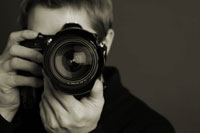 Can anyone become a great designer with the right tools? Can good design be purchased from a box, downloaded in a software program, or installed from a template online?
Can anyone become a great designer with the right tools? Can good design be purchased from a box, downloaded in a software program, or installed from a template online?
As much as we would all like to believe that there is some magic pill or program out there that can take your message and turn it into a professional and effective design, it just isn’t so. First impressions matter and good design creates a message with an impact that is quick to understand and has a purpose. Good design is the craft of creating solutions for customers and clients faced with a communication challenge or a story that needs to be told. It’s the craft of balancing brand, business and the information hierarchy, and assembling them into an organized and effective message.
Good design is the making of a few hundred intricate choices that build on each other in the process. It starts with defining a goal, and determining what information and branding elements should be used to create a solution to that goal. It’s then determining where the challenges are, and how to turn those challenges into positive assets to create a message that inspires and leads to an action. Preferably a sale.
Great content, or copy, is a good place to start, but it takes training and experience to shape typography, color theory, white space, and an information hierarchy, to name a few, to create a sophisticated and successful solution. The goal should be to create a message that executes your desired purpose. Here’s a tip: look away, then look back at the piece again quickly. What is the first thing you see? Where does your eye go to immediately? A well-designed piece will not leave that aspect to chance. It is almost a science on how to direct the viewer’s attention around the page to send a very clear message. And that message should come across quickly, and cleverly too, if it is appropriate. Your eye should ultimately end up at a clear call to action. Invariably, this would include company name, and of course, contact information.
What mood or feeling is your piece trying to portray? Do the colors inspire, calm and relax, make you excited with anticipation, or portray stability and dependability? Colors can be subtle or bold. They are just as important as the copy, maybe more so, because of the emotional responses they create so instantaneously. Is there enough open space, also known as white space, to give the viewer’s eyes a rest, producing a sense of calmness and sophistication, if that is the desired effect. If you want to create a sense of endless adventure, maybe the approach should be an overwhelming amount of imagery, or a busy page. It’s all part of the responses and reactions you are trying to create.
Is there balance, for solidity and strength, or a deliberately weighted element to draw attention and create excitement? Is there a sense of movement? Good design can use shapes, balance and weight to anchor or complement, to create motion or movement, or to mystify and tease the viewing experience. Good design is the execution of skilled visual direction with a purpose.
And then there’s typography, or typefaces, and how to use them. It takes experience and time to get to know how each font has a quality, or character, of its own. Pun intended. Bold or soft, bright or calm, busy or clean, there are infinite combinations that can present a unique message with each design. With the experienced and craftful use of graphic elements, along with purposeful direction and precise execution, good design can be timeless.

